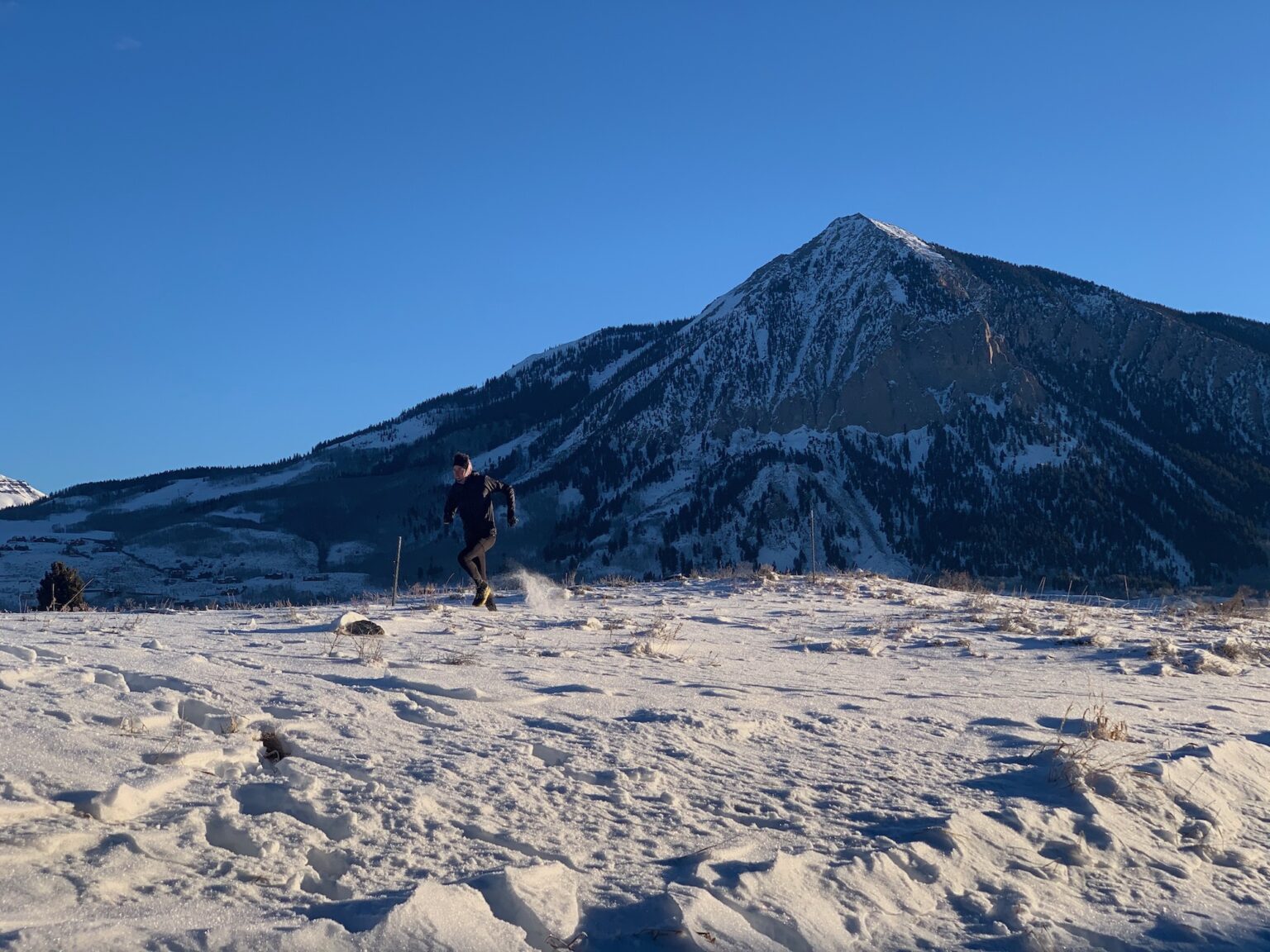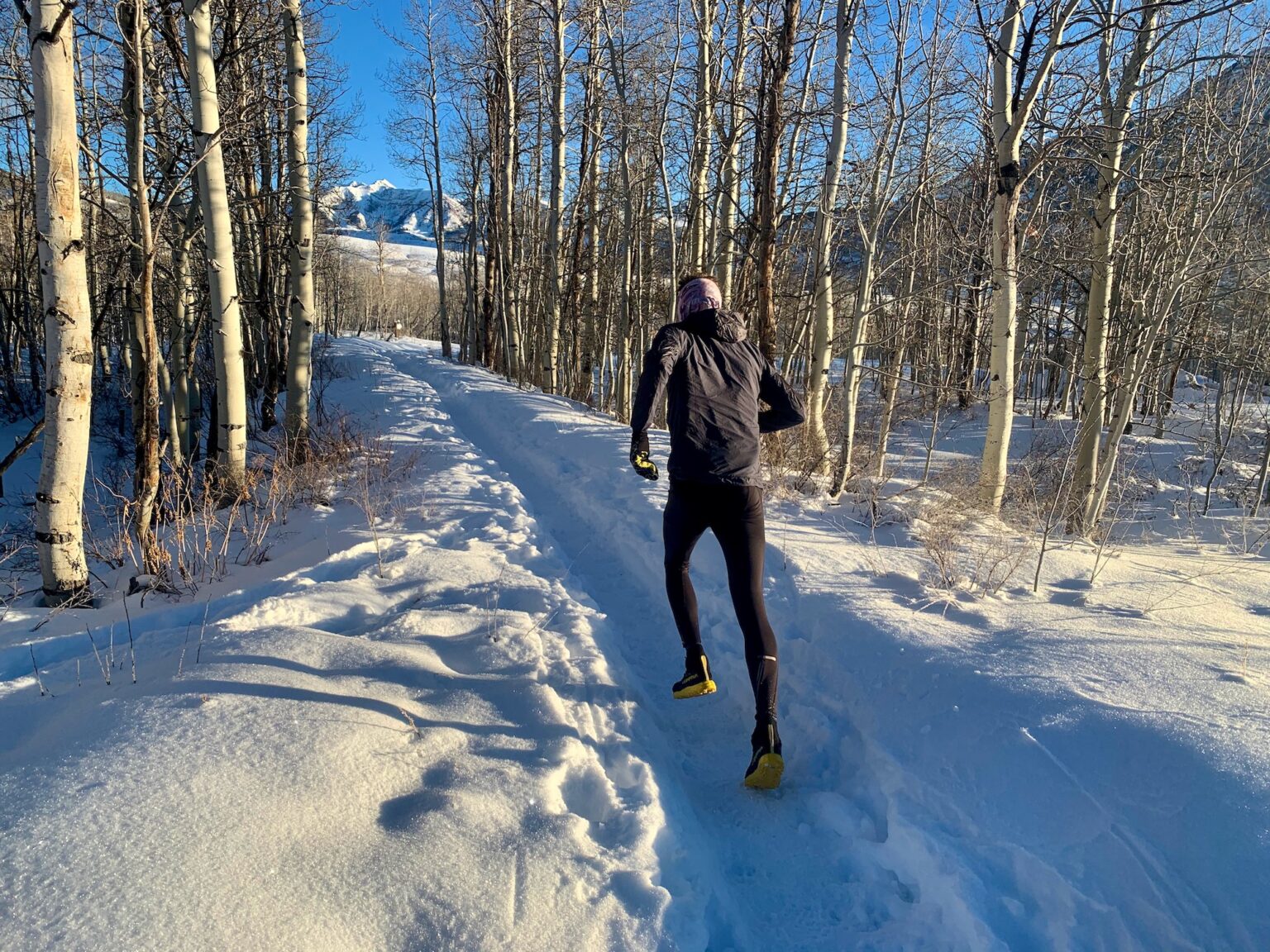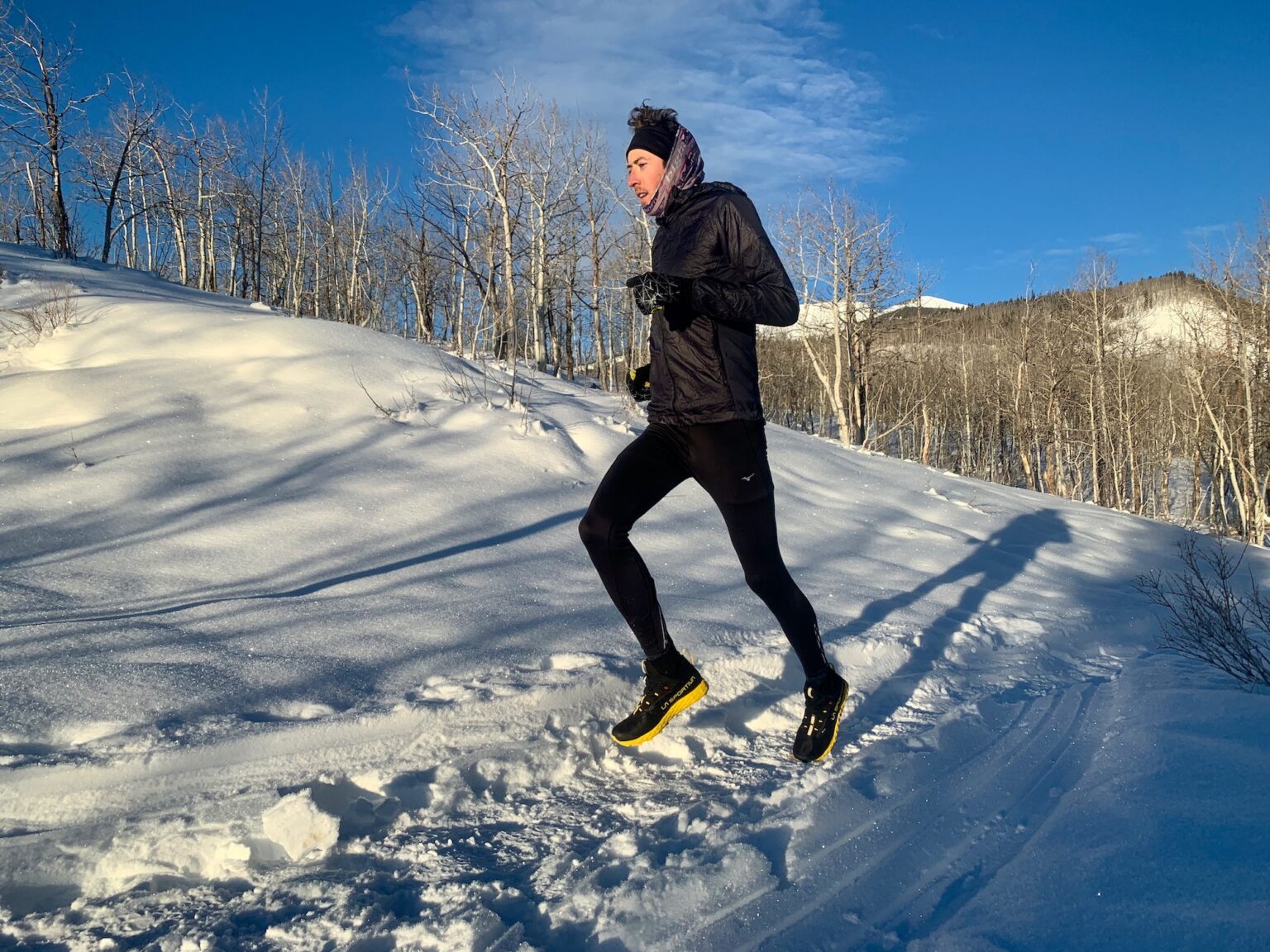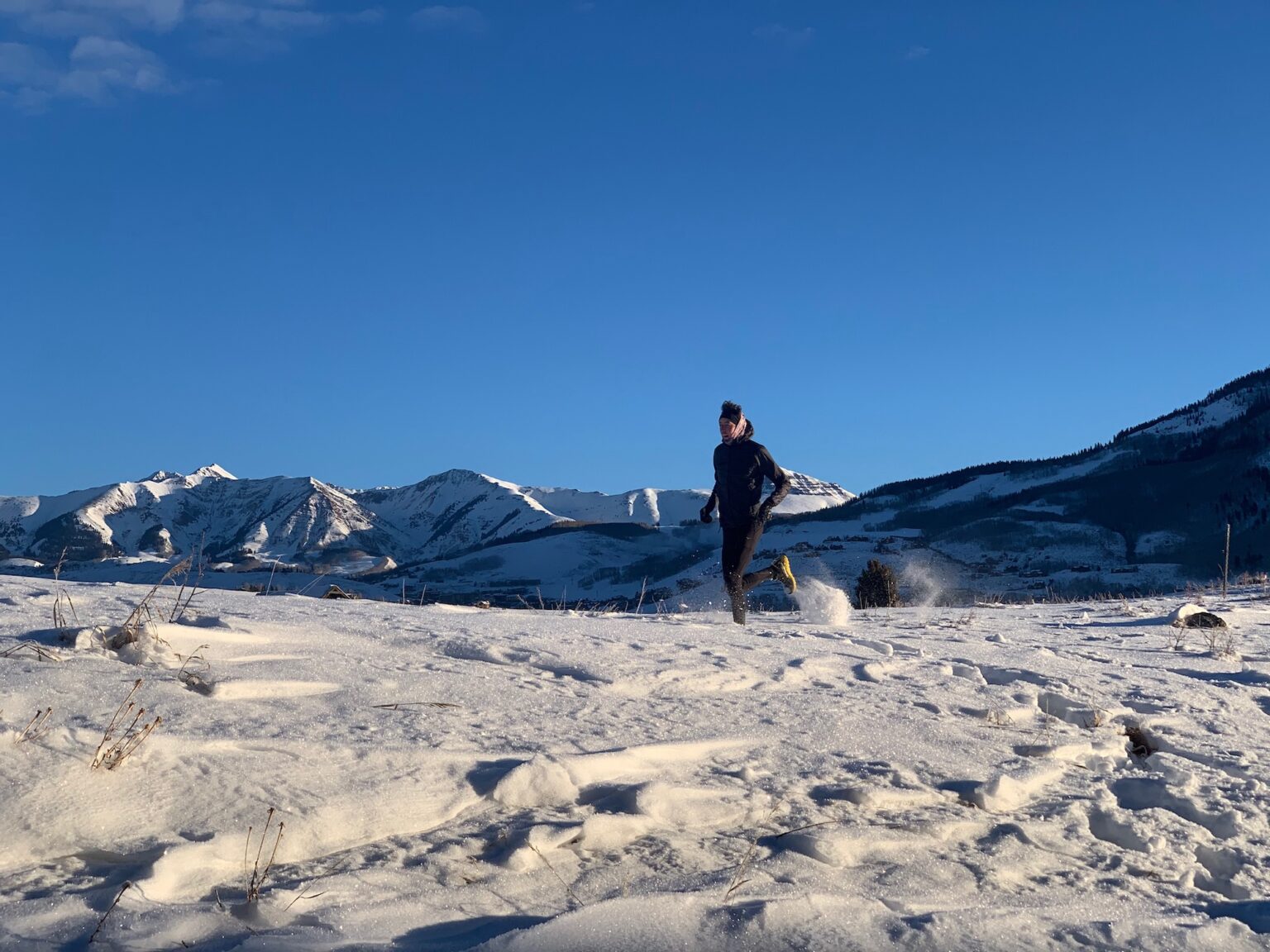La Sportiva Blizzard GTX
Test Locations: Gunnison — Crested Butte, Colorado
Test Duration: 72 miles
Stated Stack Height: 25 mm (heel) / 19 mm (forefoot)
Stated Heel-to-Toe Drop: 6 mm
Stated Features:
- Single cord lacing system with integrated garage
- 4-way stretch dynamic scree guard is water repellent and wraps foot completely protecting against rocks, mud, and snow
- High Frequency Fusion Gate structure connects to the lacing system, providing lateral / medial support and fine-tuning of fit
- Gore-Tex Extended Comfort membrane keeps shoe waterproof and highly flexible
- Durable Frixion AT 2.0 outsole with 7 mm lugs and integrated tungsten alloy hobnails for maximum traction in any conditions
Reviewer: 6’1″, 145 lbs / 185 cm, 66 kg
Size Tested: US Men’s 12
Stated Weight per Shoe (US Men’s Size 9): 377 g / 13.3 oz
Blister Measured Weight (US Men’s 11.5):
- Shoes + Laces: 402 g (left) & 401 g (right)
- Insoles: 21 g (left) & 22 g (right)
- Total: 423 g (left) & 423 g (right)
MSRP: $199
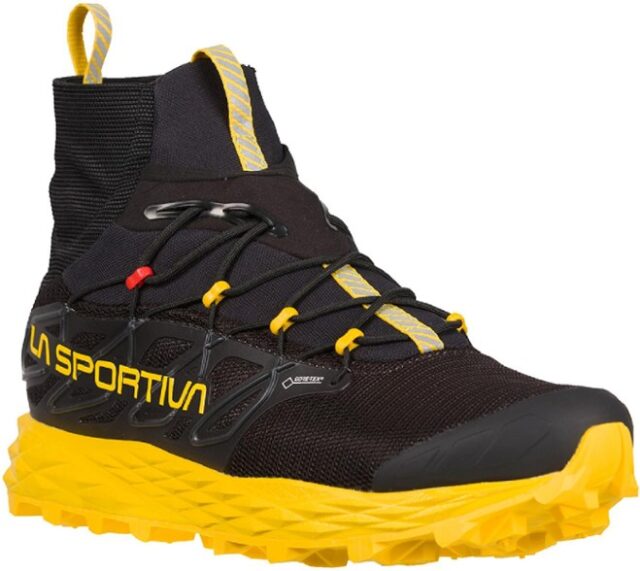
Intro
Running in the winter can be kind of tough. More often than not, it’s cold, wet, and slippery — especially in the Gunnison–Crested Butte Valley. I don’t know about you, but I get sick of slipping around in sub-freezing temperatures pretty quickly — which is precisely why shoes like the La Sportiva Blizzard GTX exist. The Blizzard GTX has an ankle-height gaiter, a waterproof / breathable Gore-Tex upper, and an aggressive outsole with built-in, tungsten-alloy spikes to provide, as La Sportiva puts it, “maximum protection and grip in the most severe conditions.”
We have no shortage of “severe conditions” in Gunnison this time of year (it was -6° F / -21° C and quite icy the morning I wrote this), so I was pretty stoked to give the Blizzard GTX a try. In the past, I’ve always just strapped a pair of Kahtoola MICROspikes to my shoes for particularly slippery winter runs. But while MICROspikes do provide pretty great traction, they aren’t overly comfortable for longer runs in my experience. They also have an annoying tendency to bunch up, get twisted, fall off, and so on. So with that in mind, the Blizzard GTX seemed like it had the potential to solve at least some of my winter running woes — and maybe even to make me more likely to get out the door for a run instead of just staying inside and eating more cookies when conditions are less than ideal.
Fit
As per usual, it’s a good idea to try the Blizzard GTX on in person before buying, if you’re able. If not, I can provide some general context on how the shoe fits my fairly narrow, low-volume feet. For reference, I usually like shoes that fit securely through the midfoot and heel but have fairly roomy / wide toeboxes.
Before I dive into the Blizzard GTX’s fit, it’s also worth mentioning that the Blizzard GTX runs fairly small — much like La Sportiva’s other shoes. I wear a US Men’s 11.5 in just about every other brand, including Salomon, Hoka, and Altra. For other La Sportiva shoes, I usually have to size up a half or even a full size — and the Blizzard GTX is no different. A US Men’s 12 feels plenty big in the Blizzard, but an 11.5 would definitely be too tight. For those familiar with other La Sportiva shoes, I’d say that the Blizzard fits very similarly to the La Sportiva Lycan II size-wise.
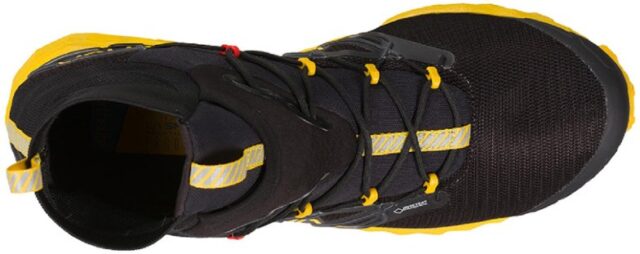
Sizing aside, I was honestly a little surprised by the Blizzard GTX’s fit. Most of La Sportiva’s shoes are fairly narrow, low volume, and secure. In short, the Blizzard GTX is not. The heel, midfoot, and toebox all feel slightly wider and much higher volume than shoes like the La Sportiva Bushido II or Kaptiva. Again, the Blizzard GTX feels most similar to the Lycan II — although I think the Blizzard is slightly more spacious / high volume, if anything.
If you have wide / high-volume feet and high arches, that should come as welcome news. Unfortunately, I don’t, so I’ve had a hard time getting the Blizzard GTX to fit securely through the heel and midfoot. As a result, my feet slide around laterally quite a bit in the Blizzard GTX on uneven terrain. I actually think the lacing system plays a bigger role in my fit struggles than the actual shape / volume of the shoe itself (more on that later), but the net result is the same. Again, I don’t think this will be an issue for runners with wider / higher-volume feet, but it is worth keeping in mind for those of us with narrower feet.
While the Blizzard GTX doesn’t feel very secure on uneven terrain for my foot shape, it is quite comfortable otherwise — I haven’t had any issues with blisters or hot spots in the shoe, and the wider fit is more comfortable for longer runs on even surfaces. I’d like the shoe more if it had a narrower / lower-volume midfoot and heel, but that’s mostly a matter of personal preference.
Weight
Speaking of personal preference, I think the Blizzard GTX could stand to lose some weight. I’ve said before that I don’t mind heavier shoes if they’re heavy for a good reason — but I’m going to amend that statement to say that I don’t mind some extra weight up to a certain point. The Blizzard GTX has every reason to be heavy (burly outsole, waterproof upper, built-in gaiter, metal spikes, etc.), but that doesn’t change the fact that a shoe with a stated weight of 377 g / 13.3 oz is going to feel pretty darn heavy on the trail. With that said, the Blizzard GTX does have a pretty similar stated weight to ankle-height, waterproof shoes from other brands (all stated weights are based on a US Men’s Size 9):
363 g / 12.8 oz — Hoka One One Speedgoat Mid GTX 2
365 g / 12.9 oz — Salomon Spikecross GTX
370 g / 13.1 oz — La Sportiva Crossover 2.0 GTX
371 g / 13.1 oz — Altra Lone Peak 4.0 Mid RSM
377 g / 13.3 oz — La Sportiva Blizzard GTX
400 g / 14.1 oz — Salomon Snowspike CSWP
420 g / 14.8 oz — Adidas Terrex Agravic Tech Pro
It’s also worth pointing out that the Salomon Snowspike CSWP is the only other shoe on this list that has an ankle-height gaiter, waterproof / breathable upper, and integrated metal spikes in the outsole — and the Snowspike is a decent amount heavier than the Blizzard GTX. But honestly, I’ve found that any shoe that tips the scales in the 13-14 oz range is bound to feel pretty cumbersome — and that certainly holds true for the Blizzard GTX. I definitely notice the shoe’s weight more than any other shoe I’ve run in recently, especially on uphills and during faster-paced runs.
The Blizzard GTX is one of the few shoes I’ve run in that actually feels like it’s slowing me down a significant amount purely because of its weight. And while I recognize that any shoe with the Blizzard GTX’s feature set is going to be fairly heavy, I think La Sportiva could trim some weight by simplifying the lacing system and tinkering with the outsole pattern. As I said at the top, that’s all just a matter of opinion. If you aren’t concerned about shoe weight, the Blizzard GTX will likely feel just fine — just don’t expect it to feel particularly fast or nimble.
Upper
The Blizzard’s upper has two basic components: the ankle gaiter, which is made of a stretchy knit material with a water-repellent coating, and the rest of the shoe, which features Gore-Tex’s waterproof / breathable Extended Comfort membrane. The midfoot also has a series of fairly rigid plastic overlays, which anchor the lacing system to the midsole. As for the lacing system itself, it consists of a fairly thin, round lace threaded through plastic eyelets. The top of the tongue has a stretchy pocket that covers the top of the lacing system, making it easy to tuck in the laces to keep them from flopping around and loosening.
In theory, I think the Blizzard GTX’s upper is a great idea. The Gore-Tex portion of the shoe does indeed do a good job of keeping my feet warm and dry, even on snowy runs in subzero temperatures. And while the gaiter itself isn’t actually waterproof, its water-repellent coating keeps snow from building up on it and soaking through to the inside of the shoe. But the upper also has a few flaws that, in my opinion, limit the Blizzard’s versatility.
First off, the top of the stretchy ankle gaiter isn’t actually tight enough to fit securely around my ankles — instead, there’s a sizable gap that does a great job of scooping snow into the shoe any time I run through snow that’s more than ankle deep. I do have pretty skinny ankles, so this probably won’t be an issue for everyone. But it seems like it’d make a whole lot of sense to put some sort of drawstring or strap around the top of the gaiter to allow you to get a secure fit, regardless of ankle size. Without that, the Blizzard’s gaiter is pretty useless for keeping anything other than shallow snow out of the shoe.
While the loose gaiter is a minor annoyance, my more significant complaint about the Blizzard’s upper is the lacing system. As I mentioned above, it consists of a thin, round lace threaded through plastic eyelets. Both the thin lace and the plastic eyelets are extremely slippery, which makes it surprisingly difficult to sufficiently tighten the lacing system. Even when I tie the laces as tightly as I can, they seem to slip around and loosen up almost instantaneously — making it extremely hard to get a secure fit. Aside from the fact that it looks cool (which has to count for something, right?), I have no idea what the point of the plastic eyelets and thin, round lace is. In addition to being way harder to tighten than a more traditional lacing system, it seems like they probably weigh more, too.
Midsole
The Blizzard GTX has a very similar midsole to the Lycan II — it uses the same compression-molded EVA material but has a slightly lower stack height (25 mm / 19 mm for the Blizzard vs. 28 mm / 22mm for the Lycan II). The Blizzard does have a noticeably firmer / more rigid ride than the Lycan II, but I think that’s mostly a result of the Blizzard’s outsole, rather than its midsole. Still, the Blizzard does not feel like a plush / cushioned shoe — the midsole provides enough shock absorption to keep my feet from getting too beat up on runs up to 2 hours long, but it certainly doesn’t feel soft.
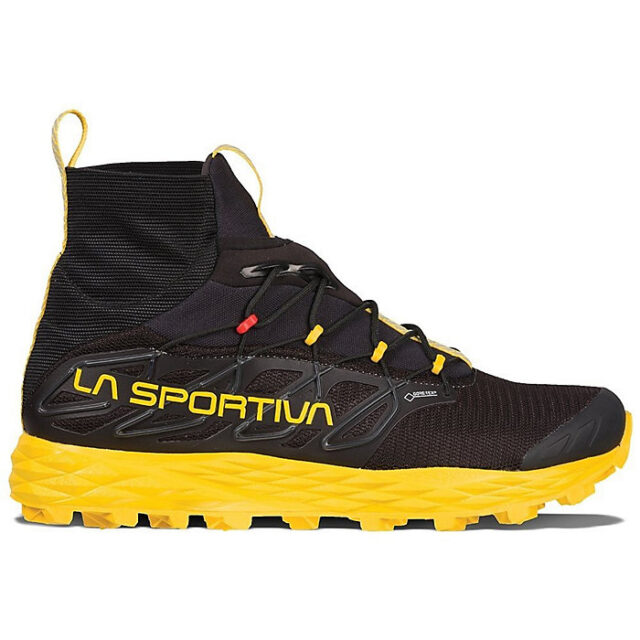
Outsole
In my opinion, the Blizzard GTX’s outsole is probably its best feature. It uses La Sportiva’s hardest, most durable Frixion AT 2.0 rubber and has large, widely spaced 7 mm hexagonal lugs. Each shoe also has 9 tungsten alloy hobnails built into the outsole — 5 in the forefoot and 4 in the heel. So far, I’ve been very impressed by the Blizzard’s traction. It feels just as grippy and secure as my MICROspikes on hard-packed snow and ice, and also provides decent traction on softer snow.

On Trail
We’ve had a pretty good start to the winter here in Gunnison, so I’ve had a chance to test the Blizzard in a fairly wide variety of winter conditions, from uncompacted, snowy trails to icy roads. While I think the Blizzard GTX is marginally better than more traditional shoes for all types of winter running, that difference is most notable on hard-packed, icy conditions.
As I mentioned above, the Blizzard does offer slightly better traction in deep snow than shoes without winter-specific outsoles — even mud-oriented shoes like the Hoka One One Evo Jawz that have extremely aggressive outsoles.
With that said, I don’t love the Blizzard for running in powder or on poorly compacted snow for two reasons. First, in powder, the ankle gaiter is too loose to keep snow out of the shoe, which pretty much negates the benefit of wearing a shoe with an ankle-height gaiter.
But the main things that deter me from wearing the Blizzard in loose snow are its weight and fit. Running in loose snow is hard enough as-is, and a heavy shoe like the Blizzard just makes it feel even harder in my experience — even if it does offer slightly more traction. On top of that, the issues I’ve had with getting the Blizzard to fit securely make it feel decidedly sloppy on soft or partially compacted snow. For my preferences, the Blizzard’s small gains in traction aren’t worth the extra weight and loose fit — so I usually opt for a lighter, more closely fitting shoe (something like the Evo Jawz) when running on soft snow.
Where the Blizzard GTX really comes into its own is on hard-packed and / or icy roads and trails. It provides way better traction than any of the other shoes I’ve run in recently, mostly thanks to the integrated metal spikes in the outsole. In addition, the Blizzard’s heavier weight and looser fit aren’t as noticeable on smoother, more even surfaces.
With all that in mind, I mostly just use the Blizard GTX for runs on snowy / icy roads at this point and stick to lighter, closer-fitting shoes for running on the trails — even though they don’t offer quite as much traction. Personally, I’d have kind of a hard time justifying spending $200 on a pair of shoes that I’m only going to use for runs in a specific type of conditions during one season of the year. But it’s important to remember that most of the issues I’ve mentioned about the Blizzard GTX are pretty much a matter of personal preference — I prioritize lighter weight and a more precise fit over maximum traction in the winter, but I’m sure there will be plenty of runners out there who disagree with that sentiment.
Durability
One benefit of a shoe that weighs 377 g / 13.3 oz is that it’s probably going to be pretty darn durable — and that certainly seems to be the case with the Blizzard. I’ve always been impressed by the overall quality of La Sportiva’s shoes, and the Blizzard GTX certainly seems like it’s built to last. The upper fabric is fairly thick, and shows no signs of wear or fraying after 70 miles of use. The outsole is also still in great shape, which probably isn’t all that surprising since I’ve only really worn the Blizzards on snow-covered surfaces.
Obviously, I’ll have to put more miles in the Blizzard before I can draw any definite conclusions about its long-term durability, and I’ll update this section later on once I’ve had the chance to do that. But so far, it certainly seems like the Blizzard will last for several hundred more miles.
Who’s It For?
I think the Blizzard is probably best suited to people who spend a lot of time running on hard-packed, icy roads and trails. If you have higher-volume feet, it might also be a solid option for looser snow and more uneven surfaces, but it felt a little sloppy in those conditions for my foot shape and fit preferences. It goes without saying that the Blizzard GTX is a fairly specialized shoe — I certainly wouldn’t recommend it for runs that consist of a mix of dirt, pavement, and snow. But if you live somewhere that has long, snowy winters, the Blizzard GTX could be a pretty compelling option to have in your larder for the winter months.
Bottom Line
As I said in the intro, the La Sportiva Blizzard GTX doesn’t magically make winter running “easy” — and I don’t think any shoe ever will. Running in the winter is always going to be slower, colder, and more slippery than cruising dry singletrack in the summer months. Still, I do like having the Blizzard as an option for days when I know I’m going to be running on slippery, hard-packed roads and trails. And while the $200 price tag might seem excessive for such a specialized shoe, I think you can also make the argument that the Blizzard GTX is a fairly long-term investment.
Unlike most running shoes, I really only anticipate using the Blizzard a few times a week (at the most) throughout the winter. And since it does seem to be a pretty durable shoe, I expect that it’ll last several winters with that level of use. So if you are looking for a warm, protective, and grippy shoe for winter running, I think there’s a pretty good argument to be made for snagging a pair of the Blizzard GTX — even if it won’t always keep you from sitting by the fire and eating cookies instead of going for a run when it’s cold and icy outside.

